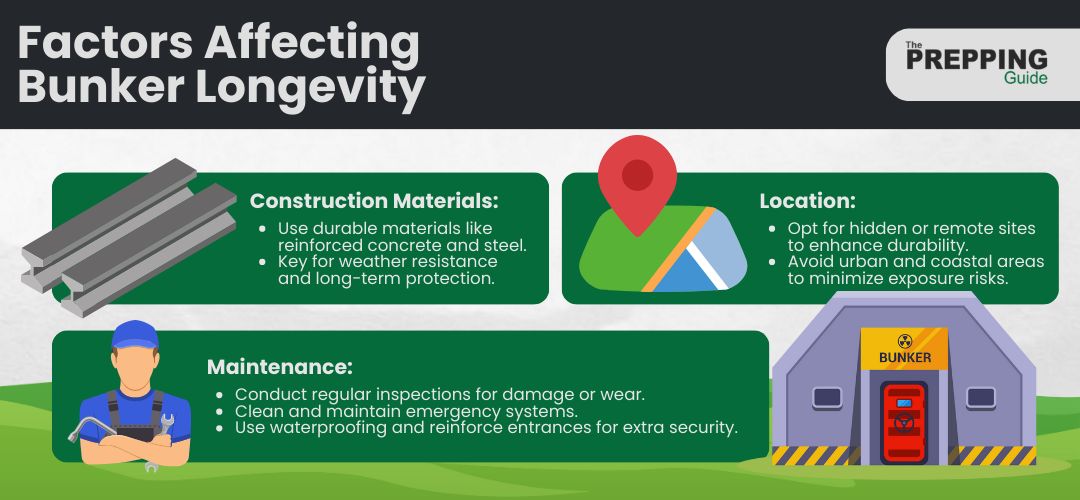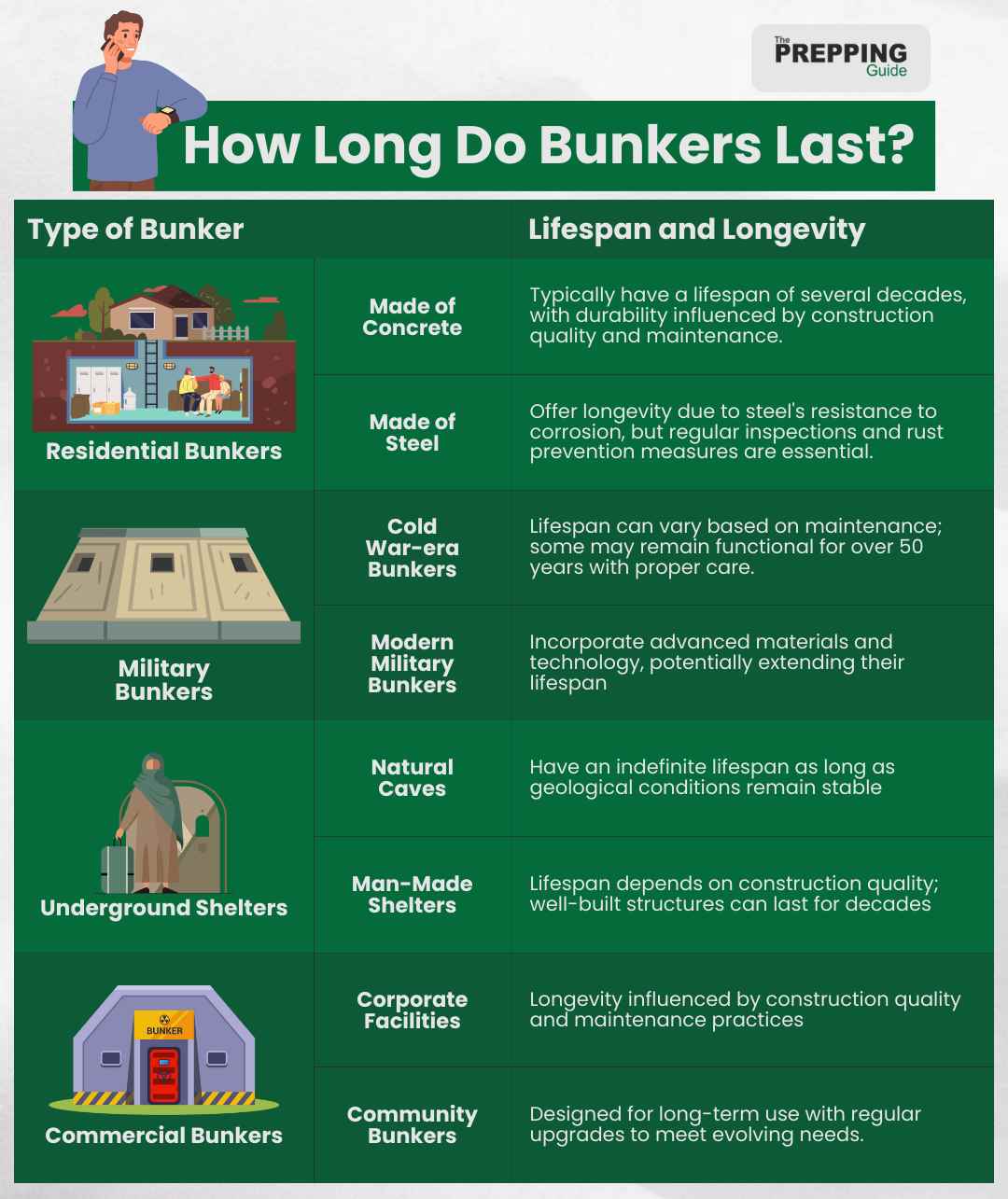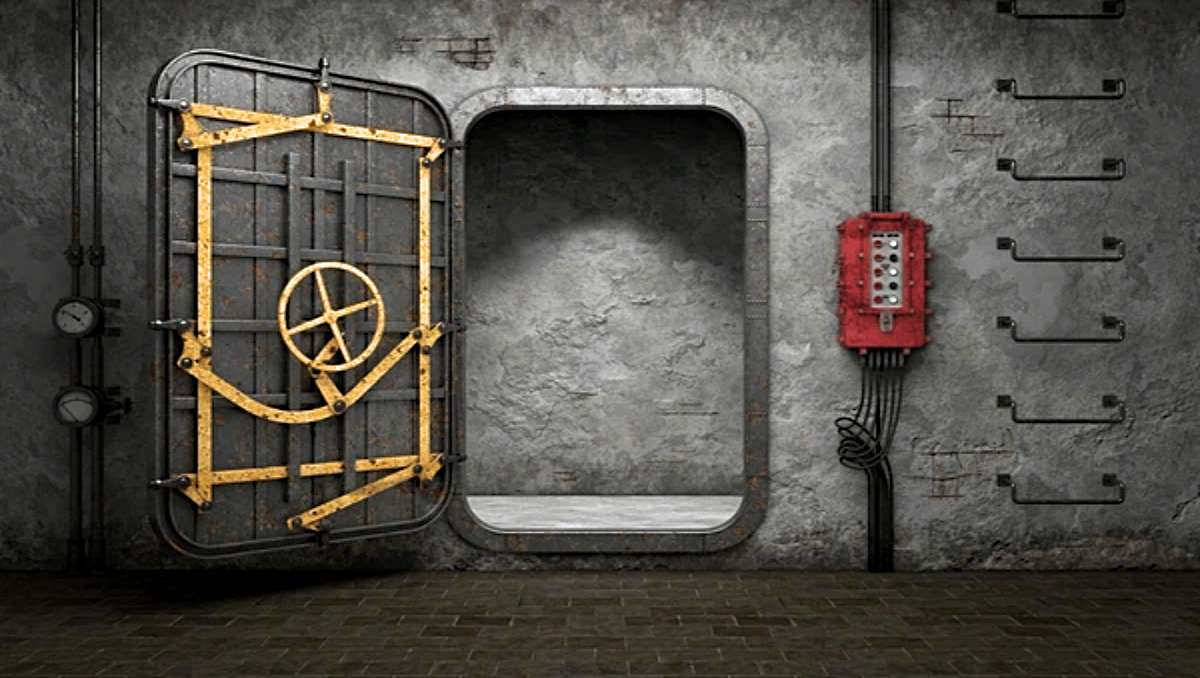So, you’ve decided to bunker down and build yourself a safe haven when the world goes topsy-turvy. But how long do bunkers actually last? That’s the burning question on your mind as you embark on this underground adventure.
Bunkers, when properly constructed and maintained, can last for several decades to over a century. The lifespan of a bunker depends on factors such as the quality of construction materials, structural design, and ongoing maintenance efforts.
In this article, we’ll dive deep into the world of bunkers to uncover their true longevity. From traditional fallout shelters to modern survival bunkers, there are various types, each with its own lifespan. Buckle up and get ready to explore the fascinating world of bunker durability!
The Purpose of Bunkers and Their Longevity
Bunkers serve a crucial purpose as secure and protective structures designed to withstand various environmental and man-made threats. Originally conceived as military fortifications to shelter personnel and equipment during wartime, bunkers have evolved to encompass a broader range of applications.
Today, bunkers such as storm shelters, bomb shelters, and secure storage facilities are utilized for civilian purposes. Their longevity is closely tied to their intended purpose and the quality of construction. Bunkers constructed with durable materials and robust engineering techniques can endure for extended periods, ensuring their effectiveness in providing safety and protection.
The longevity of bunkers is intricately linked to the ongoing maintenance and adaptation of these structures. Regular inspections, repairs, and updates are essential to address wear and tear, environmental changes, and technological advancements.
Bunker owners and operators must stay vigilant in preserving the structural integrity of these shelters to ensure their continued functionality. Additionally, advancements in construction materials and techniques enhance the overall longevity of bunkers, allowing them to serve their purpose effectively over the years.
Types of Bunkers

In this discussion of types of bunkers, you’ll explore various categories such as residential bunkers, military bunkers, underground shelters, and commercial bunkers.
Residential Bunkers
Residential bunkers are secure and fortified structures designed to provide a safe haven for individuals and families during emergencies or disasters. These bunkers are typically installed on or near residential properties and are equipped with essential supplies and amenities to sustain occupants for an extended period.
The primary purpose of residential bunkers is to offer protection against a range of threats, including natural disasters like tornadoes, hurricanes, earthquakes, civil unrest, or other unforeseen emergencies.
Features commonly found in residential bunkers may include reinforced walls, secure entry points, ventilation systems, and provisions for food and water storage. The goal is to create a secure environment where occupants can seek refuge until the threat subsides or help arrives.
Military Bunkers
Military bunkers are fortified structures specifically designed to serve various military purposes, protecting personnel, equipment, and strategic assets during times of conflict or emergencies. These bunkers are built to withstand a range of threats, including bomb blasts, artillery fire, chemical attacks, and other forms of aggression.
The design and construction of military bunkers prioritize durability, security, and functionality to ensure the continued operation of military forces, even in hostile environments.
The locations of these bunkers are often strategically chosen to maximize defensive capabilities and minimize vulnerability to enemy attacks. Some military bunkers are underground, providing an added layer of protection against aerial and ground threats.
Underground Shelters
Underground shelters are secure structures built below ground level to provide protection and refuge during emergencies or disasters. These shelters are designed to safeguard individuals, families, or communities from various threats, including natural disasters, nuclear fallout, severe weather events, or other hazardous conditions.
The primary characteristic of underground shelters is their subterranean location, which offers added protection against external elements.
The design of underground shelters varies and can include reinforced concrete structures, prefabricated bunkers, or repurposed spaces such as basements. The construction often incorporates features to withstand external pressures, such as reinforced walls and ceilings, secure entry points, and ventilation systems to ensure a fresh air supply.
Commercial Bunkers
Commercial bunkers are structures designed for business and industrial purposes to protect valuable assets, sensitive information, or essential equipment in emergencies or security threats. These bunkers are tailored to the specific needs of businesses and organizations, offering secure and resilient spaces to safeguard critical resources.
The primary goal of commercial bunkers is to ensure the continuity of operations and protect assets from various potential risks.
Commercial bunkers can take different forms, including secure storage facilities, emergency operation centers, or specialized spaces designed to handle sensitive materials securely. The construction of these bunkers prioritizes security features such as reinforced walls, advanced access control systems, surveillance technology, and sometimes even protective measures against environmental hazards or attacks.
Factors Affecting Bunker Longevity

When considering factors affecting bunker longevity, it’s important to take into account the construction materials used in its creation. Additionally, the location of the bunker and regular maintenance plays a significant role in determining its lifespan.
Construction Materials
The choice of building materials plays a crucial role in determining the structural integrity and longevity of a bunker. Bunkers are typically constructed using reinforced concrete, steel, or even specialized composite materials that offer exceptional durability factors.
These materials provide excellent weather resistance, ensuring that the bunker can withstand harsh environmental conditions over time. By using long-lasting construction materials, bunkers can offer long-term protection for occupants and essential supplies stored within them.
The combination of these high-quality building materials ensures that bunkers have a strong foundation and robust structure, making them reliable shelters for extended periods in times of need.
Location
Bunker locations play a crucial role in determining their longevity.
Hidden bunkers, strategically camouflaged within dense vegetation or underground, tend to last longer due to their discrete nature.
Remote bunkers, located far away from densely populated areas or potential conflict zones, also have a higher chance of lasting for extended periods.
Urban bunkers face more exposure to environmental factors and human activities, potentially reducing their lifespan.
Coastal bunkers are at risk of corrosion due to saltwater exposure, requiring regular maintenance to ensure durability.
Choosing the right location for your bunker is essential for its long-term viability and functionality.
Maintenance
Ensuring your bunker is regularly maintained is crucial for its overall functionality and durability. Proper bunker upkeep is essential in extending its lifespan and ensuring it remains a reliable shelter in times of need. Here are some maintenance tips to help increase the longevity of your bunker:
1. Regularly inspect all structural components for any signs of wear or damage.
2. Keep the interior clean and free from debris to prevent potential hazards.
3. Test emergency systems such as ventilation, lighting, and communication devices on a regular basis.
4. Apply preservation techniques such as waterproofing sealants to protect against moisture infiltration.
5. Implement durability measures like reinforcing doors and windows to enhance security and strength.
By following these strategies, you can ensure that your bunker remains a safe and secure refuge for years to come.
Lifespan of Different Bunker Types

Regarding the lifespan of different types of bunkers, it’s important to analyze the durability and construction materials used. The longevity of residential bunkers, military bunkers, underground shelters, and commercial bunkers differ based on the factors we mentioned above.
Residential Bunkers (Concrete and Steel)
Residential bunkers made of concrete and steel can provide long-lasting protection for you and your family.
Concrete bunkers are known for their strength and longevity, with some lasting for decades without any significant deterioration. Steel bunkers, on the other hand, offer excellent shelter security due to their robust construction methods.
When it comes to survival essentials, these residential bunkers are designed to withstand various environmental threats and ensure your emergency preparedness. Whether it’s a natural disaster or a man-made crisis, having a reliable shelter like a concrete or steel bunker can give you peace of mind, knowing that your family is safe and secure in times of need.
Military Bunkers (Cold War-Era and Underground)
For military bunkers, you’ll find that Cold War-era designs and underground structures offer unparalleled security and protection. These military fortifications are built to withstand the test of time, with bunker durability being a top priority.
Cold War bunkers were constructed using reinforced concrete and steel materials, ensuring their longevity even in harsh conditions. The underground resilience of these bunkers provides added protection against various threats, making them ideal for long-term strategic use.
Factors such as proper maintenance, ventilation systems, and sturdy construction all contribute to the lasting power of military bunkers. When considering longevity factors, these Cold War-era underground bunkers prove to be reliable assets for defense and security purposes for extended periods.
Underground Shelters (Natural Caves and Man-Made)
Natural caves, with their natural formations and sturdy structure, can provide a solid foundation for underground shelters. Their durability is reliant on the stability of the surrounding geological features.
On the other hand, man-made shelters have a specific lifespan determined by the quality of construction materials used and maintenance efforts. Factors such as shelter location, construction materials, and regular upkeep play a crucial role in determining the longevity of these underground bunkers.
By ensuring proper maintenance and utilizing durable construction materials, underground shelters can last for extended periods.
Commercial Bunkers (Corporate Facilities and Community Bunkers)
The lifespan of commercial bunkers, including corporate facilities and community bunkers, can vary based on the construction materials, maintenance practices, and technological advancements.
With careful planning and periodic updates to meet evolving safety standards, community bunkers can remain operational for an extended period. Routine drills, structural assessments, and adherence to safety regulations are crucial for ensuring the longevity of these communal shelters.
In both cases, the commitment to proactive maintenance and periodic upgrades plays a vital role in extending the lifespan of commercial bunkers. Additionally, advancements in construction materials and technologies may allow for retrofitting or improvements over time, further contributing to their overall durability.
Best Practices for Bunker Longevity
When considering the longevity of a bunker, it’s essential to focus on design considerations, construction techniques, and regular maintenance routines.
Design Considerations
You should consider factors such as structural integrity, ventilation systems, and proper materials for construction to ensure the bunker’s longevity. Consider the following design considerations:
- Ventilation systems are crucial to prevent the buildup of harmful gases and ensure a constant airflow within the bunker.
- Emergency exits should be strategically placed for quick and safe evacuation in case of an emergency.
- Reinforced structures are essential to withstand external pressures and maintain the integrity of the bunker over time.
- Waterproofing methods must be implemented to protect against water damage and potential leaks.
- The interior layout should be well-planned to optimize space usage and functionality within the bunker.
Construction Techniques
Building a lasting bunker requires the implementation of specific construction techniques aimed at ensuring durability, structural integrity, and long-term effectiveness. The choice of construction materials is paramount, with reinforced concrete and steel being common choices for their resilience against various threats.
Proper engineering techniques, such as designing foundations to absorb shocks and stresses, contribute to the bunker’s ability to withstand external pressures. The use of advanced construction methods, including modular designs and prefabricated components, can expedite the building process while maintaining quality.
In this captivating video shared by The Container Guy, he imparts his expert DIY bunker construction tips, starting with the selection of suitable shipping containers as the primary building blocks.
Regular Maintenance Routines
Ensuring your shelter remains in top condition requires consistent upkeep and attention to detail. Routine inspections are essential to identify any potential issues early on. Preventive maintenance can help prolong the lifespan of your bunker.
Establishing regular cleaning schedules and maintaining ventilation systems is crucial for a healthy environment inside the shelter. Waterproofing techniques should be employed to prevent water damage, while pest control measures can keep unwanted visitors at bay.
In addition, it’s important to have emergency repair plans in place and be prepared for disasters that may require immediate action.
Future Trends in Bunker Construction
In looking ahead to the future of bunker construction, you’ll see emerging technologies playing a crucial role in revolutionizing how a bunker is designed and built. Sustainable practices will be increasingly prioritized, with a focus on environmentally friendly materials and energy-efficient solutions.

Sustainable Bunker Construction
With the integration of sustainable practices, bunkers are being constructed with a focus on environmental impact and longevity. Eco-friendly materials and green construction techniques are now widely used to ensure energy efficiency and reduce carbon footprint.
Climate resilience and disaster preparedness are key considerations in the design phase, incorporating innovative technologies for optimal performance. This modern bunker not only prioritize long-term durability but also aim to minimize their environmental impact.
Emerging Technologies
Bunker innovations are incorporating technological advancements to enhance underground architecture, ensuring better survival strategies and sustainable designs.
With the use of advanced materials like carbon fiber-reinforced polymers for increased strength and durability, a bunker can withstand harsh conditions for longer periods. Additionally, innovative ventilation systems equipped with air purification technology help maintain a healthy environment inside the bunker for extended stays.
The integration of smart sensors and monitoring systems allows for real-time data collection on structural integrity, air quality, and energy efficiency. These emerging technologies are reshaping the future of bunker construction, providing enhanced safety and comfort for long-term sheltering needs.
Adaptations for Changing Environmental Conditions
Climate change and extreme weather events pose challenges for bunker structures, prompting the need for modifications to enhance their resilience.
Bunker modifications include reinforced materials to withstand strong winds, and advanced water management techniques to combat flooding.
Environmental resilience is at the core of these survival strategies, ensuring that bunkers can continue to provide safety and security in a rapidly changing world.
Beyond Survival: Ensuring Longevity in Your Bunker
In conclusion, bunkers are essential structures designed for protection and security. Their longevity is influenced by various factors such as construction materials, maintenance practices, and environmental conditions.
Symbolically, bunkers represent resilience and preparedness in the face of adversity. By following best practices in bunker construction and upkeep, their lifespan can be extended significantly.
As technology advances, we can expect to see more innovative designs and materials that will further enhance the durability and effectiveness of bunkers for years to come.
